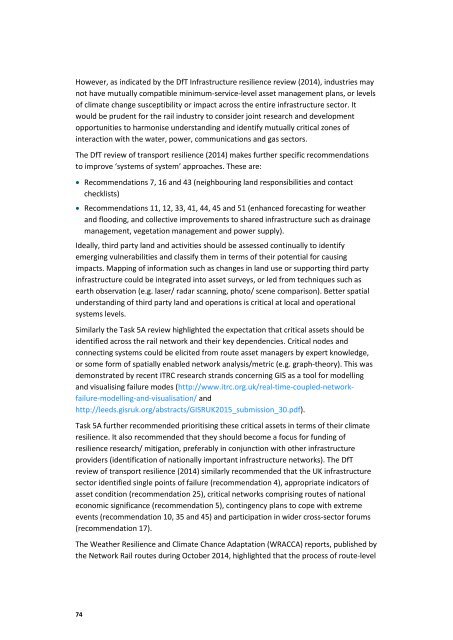Tomorrow's Railway and Climate Change Adaptation Final Report
2016-05-T1009-final-report
2016-05-T1009-final-report
Create successful ePaper yourself
Turn your PDF publications into a flip-book with our unique Google optimized e-Paper software.
However, as indicated by the DfT Infrastructure resilience review (2014), industries may<br />
not have mutually compatible minimum-service-level asset management plans, or levels<br />
of climate change susceptibility or impact across the entire infrastructure sector. It<br />
would be prudent for the rail industry to consider joint research <strong>and</strong> development<br />
opportunities to harmonise underst<strong>and</strong>ing <strong>and</strong> identify mutually critical zones of<br />
interaction with the water, power, communications <strong>and</strong> gas sectors.<br />
The DfT review of transport resilience (2014) makes further specific recommendations<br />
to improve ‘systems of system’ approaches. These are:<br />
• Recommendations 7, 16 <strong>and</strong> 43 (neighbouring l<strong>and</strong> responsibilities <strong>and</strong> contact<br />
checklists)<br />
• Recommendations 11, 12, 33, 41, 44, 45 <strong>and</strong> 51 (enhanced forecasting for weather<br />
<strong>and</strong> flooding, <strong>and</strong> collective improvements to shared infrastructure such as drainage<br />
management, vegetation management <strong>and</strong> power supply).<br />
Ideally, third party l<strong>and</strong> <strong>and</strong> activities should be assessed continually to identify<br />
emerging vulnerabilities <strong>and</strong> classify them in terms of their potential for causing<br />
impacts. Mapping of information such as changes in l<strong>and</strong> use or supporting third party<br />
infrastructure could be integrated into asset surveys, or led from techniques such as<br />
earth observation (e.g. laser/ radar scanning, photo/ scene comparison). Better spatial<br />
underst<strong>and</strong>ing of third party l<strong>and</strong> <strong>and</strong> operations is critical at local <strong>and</strong> operational<br />
systems levels.<br />
Similarly the Task 5A review highlighted the expectation that critical assets should be<br />
identified across the rail network <strong>and</strong> their key dependencies. Critical nodes <strong>and</strong><br />
connecting systems could be elicited from route asset managers by expert knowledge,<br />
or some form of spatially enabled network analysis/metric (e.g. graph-theory). This was<br />
demonstrated by recent ITRC research str<strong>and</strong>s concerning GIS as a tool for modelling<br />
<strong>and</strong> visualising failure modes (http://www.itrc.org.uk/real-time-coupled-networkfailure-modelling-<strong>and</strong>-visualisation/<br />
<strong>and</strong><br />
http://leeds.gisruk.org/abstracts/GISRUK2015_submission_30.pdf).<br />
Task 5A further recommended prioritising these critical assets in terms of their climate<br />
resilience. It also recommended that they should become a focus for funding of<br />
resilience research/ mitigation, preferably in conjunction with other infrastructure<br />
providers (identification of nationally important infrastructure networks). The DfT<br />
review of transport resilience (2014) similarly recommended that the UK infrastructure<br />
sector identified single points of failure (recommendation 4), appropriate indicators of<br />
asset condition (recommendation 25), critical networks comprising routes of national<br />
economic significance (recommendation 5), contingency plans to cope with extreme<br />
events (recommendation 10, 35 <strong>and</strong> 45) <strong>and</strong> participation in wider cross-sector forums<br />
(recommendation 17).<br />
The Weather Resilience <strong>and</strong> <strong>Climate</strong> Chance <strong>Adaptation</strong> (WRACCA) reports, published by<br />
the Network Rail routes during October 2014, highlighted that the process of route-level<br />
74


